“Second Nature,” the current exhibit at The Gallery at Penn College, is attracting educational interest from students and faculty, including psychology, sociology, English composition and art classes.
The most recent class to visit was Research Methods (SOC313), taught by Rob Cooley, associate professor of anthropology/environmental science, and Elizabeth E. Winder, assistant professor of human services.
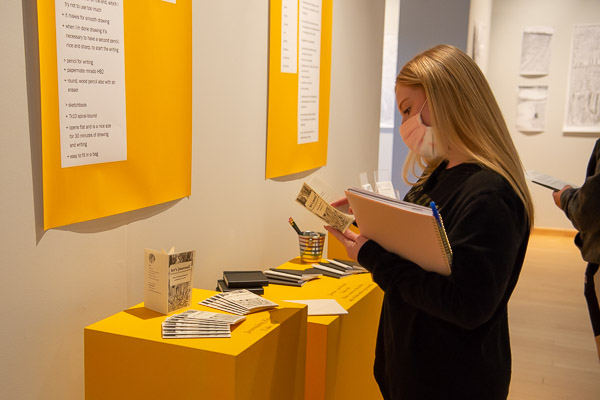
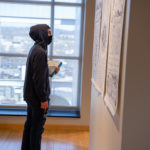
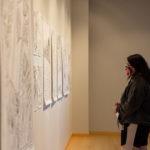 “We want the students to explore the exhibit and take notes describing their own personal responses to it,” Cooley explained. “Then, they'll analyze their notes, individually and as a group, identifying codes, themes, and making meaning out of their interpretations. Essentially, it will show how qualitative analysis of seemingly discrete individual experiences can reveal a set of previously unknown themes shared by the group."
“We want the students to explore the exhibit and take notes describing their own personal responses to it,” Cooley explained. “Then, they'll analyze their notes, individually and as a group, identifying codes, themes, and making meaning out of their interpretations. Essentially, it will show how qualitative analysis of seemingly discrete individual experiences can reveal a set of previously unknown themes shared by the group."
Additionally, the Research Methods class is populated by human services and restorative justice majors, along with emergency management and homeland security students, so Winder said it might be helpful to identify how they can use journaling professionally – "the value of journaling as a therapeutic strategy for those in the helping professions."
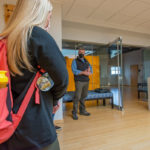
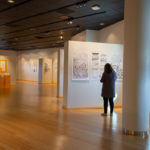 Showcasing graphic designer Sarah Patterson's 100-day journaling practice, "Second Nature" is on display through April 9.
Showcasing graphic designer Sarah Patterson's 100-day journaling practice, "Second Nature" is on display through April 9.
Located on the third floor of the Madigan Library, the gallery is open to the campus community and the general public on Mondays, Tuesdays and Thursdays, 2 to 8 p.m.; and Wednesdays and Fridays, 10 a.m. to 4 p.m. (The gallery is closed on weekends.) The exhibit is supplemented with journaling resources for visitors to explore.
A virtual exhibit of "Second Nature" is also available on the gallery's website.
Another faculty member – Robin L. Stetter, instructor of speech communication/composition – recently introduced a number of students to the gallery, finding Patterson's discipline a timely fit for her class discussions.
"The core tenet of our writing class is that writing is thinking," she said. "The exhibit opened opportunity to discuss the process of journaling, and each of the students embarked on a weeklong daily practice of journaling. Part of the assignment was for them to compete two entries following Sarah's model: sketching a snapshot of something they saw during the day and journaling around it."
At the end of the week's exercise, she said, students spent class time discussing their experience and the ways in which it aids metacognition – awareness of the thinking and learning process.
"Many of the students are still choosing to journal (maybe not daily, though)," added Stetter, who said Patterson's research led the class to explore other aspects of handwriting and turning ideas into self-expression.
The most recent class to visit was Research Methods (SOC313), taught by Rob Cooley, associate professor of anthropology/environmental science, and Elizabeth E. Winder, assistant professor of human services.


 “We want the students to explore the exhibit and take notes describing their own personal responses to it,” Cooley explained. “Then, they'll analyze their notes, individually and as a group, identifying codes, themes, and making meaning out of their interpretations. Essentially, it will show how qualitative analysis of seemingly discrete individual experiences can reveal a set of previously unknown themes shared by the group."
“We want the students to explore the exhibit and take notes describing their own personal responses to it,” Cooley explained. “Then, they'll analyze their notes, individually and as a group, identifying codes, themes, and making meaning out of their interpretations. Essentially, it will show how qualitative analysis of seemingly discrete individual experiences can reveal a set of previously unknown themes shared by the group."Additionally, the Research Methods class is populated by human services and restorative justice majors, along with emergency management and homeland security students, so Winder said it might be helpful to identify how they can use journaling professionally – "the value of journaling as a therapeutic strategy for those in the helping professions."

 Showcasing graphic designer Sarah Patterson's 100-day journaling practice, "Second Nature" is on display through April 9.
Showcasing graphic designer Sarah Patterson's 100-day journaling practice, "Second Nature" is on display through April 9.Located on the third floor of the Madigan Library, the gallery is open to the campus community and the general public on Mondays, Tuesdays and Thursdays, 2 to 8 p.m.; and Wednesdays and Fridays, 10 a.m. to 4 p.m. (The gallery is closed on weekends.) The exhibit is supplemented with journaling resources for visitors to explore.
A virtual exhibit of "Second Nature" is also available on the gallery's website.
Another faculty member – Robin L. Stetter, instructor of speech communication/composition – recently introduced a number of students to the gallery, finding Patterson's discipline a timely fit for her class discussions.
"The core tenet of our writing class is that writing is thinking," she said. "The exhibit opened opportunity to discuss the process of journaling, and each of the students embarked on a weeklong daily practice of journaling. Part of the assignment was for them to compete two entries following Sarah's model: sketching a snapshot of something they saw during the day and journaling around it."
At the end of the week's exercise, she said, students spent class time discussing their experience and the ways in which it aids metacognition – awareness of the thinking and learning process.
"Many of the students are still choosing to journal (maybe not daily, though)," added Stetter, who said Patterson's research led the class to explore other aspects of handwriting and turning ideas into self-expression.
